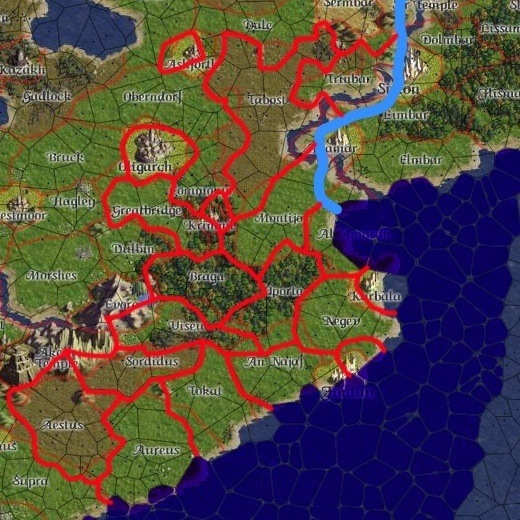Conceptual Overview
The purpose of this is to generate a bottom-up system of regions, duchies, realms, etc. So we start from the lowest reasonable element and build up.
Walkthrough
|
Our "unit" will be the place. A place is a single settlement on the map and its related areas. A settlement can be of any size, it coulde be a village, a town, a castle or a city. The area around it is the area this settlement claims as its own, belongs to it geographically. We could go looking for geographic features and derive the area from that, but it is easier to do it the other way around: Draw Voronoi cells around the settlements and define the geographic features based on their edges. For cities, the place is the city itself and the edges are the city walls.
This gives us a basic segmentation of our map, for example like shown on the right.
The dots in this image are the settlements, and the lines are the borders between areas. The "tiles" are the places.
| 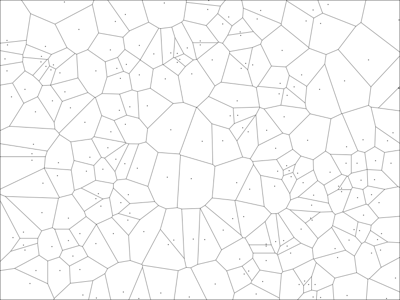 |
|
Let us select three places at random and use them for the following examples:
| 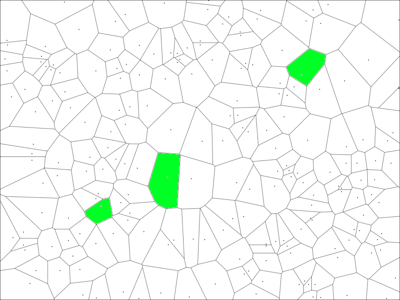 |
Estates
An estate is a knights place of residence. It is always located in a place, but it can control several places. So a single knight could control a village, or he could control a castle and three surrounding villages, etc. In our example, this could look like shown on the right.
The middle estate only controls one place, but it's a pretty large place. The two other estates control several places. So in the example bottom-left, you have the place X which also rules the other three nearby places.
A knight can only control places that border his residence, so an estate is always a continuous area. This also puts a size limit on estates.
| 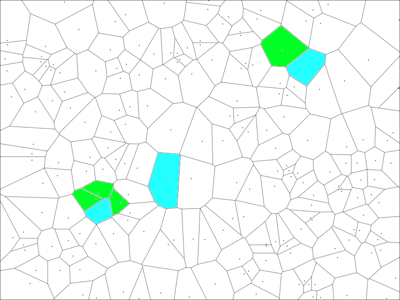 |
Regions
Estates can band together to form regions. A region is an area that will be visible on the world map. Every estate always belongs to a region, though it can "belong" to itself, just like places always belong to an estate. So place, estate and region can all be the identical one unit, though that is unlikely.
In our example, the two left-most estates belong to the same region, so they are now part of the same hierarchy, and their knights share a common lord. If in our example the leftmost estate is the region "capital", then the other estate would be its vassal.
Regions also have names, independent of their estates or places. The region top-right could be Keplerstan, which consists of the town Keplerville and the four villages Kepple, Kipple, Kapple and Kopple.
| 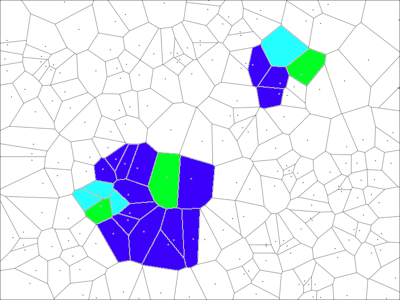 |
Baronies, Duchies, etc
Regions can band together into higher-level entities. There is no theoretical limit to the depth of this hierarchy, so several regions could form a barony, several baronies a duchy, several duchies a... - on a practical level, one or two layers is probably the maximum that will work.
This layer is optional. In our example on the right, the other regions belonging to the same duchy as our examples are marked in yellow. The top-right region does not belong to a barony/duchy/etc while the lower-left region (containing our two example estates there) does.
These intermediate layers mainly serve as vehicles for player creativity. They make it possible to create different kinds of realms, with flat or deep hierarchies, with intricate systems or simple ones. This layer serves as the foundation of pretty much any imaginable feudal system that players want to come up with.
Players can name these layers at will, and a game name following the syntax (layer title) of (capital region) will be generated and used by the game. For example, the name could be "Barony of Keplerstan". This makes it clear what one is talking about. If something says just "Keplerstan", it is talking about the region ("Enemy forces have looted the village Kapple in Keplerstan."), while talk with the title refers to the political entity - "You are now entering the Barony of Keplerstan" does not necessarily mean I am entering the region Keplerstan.
| 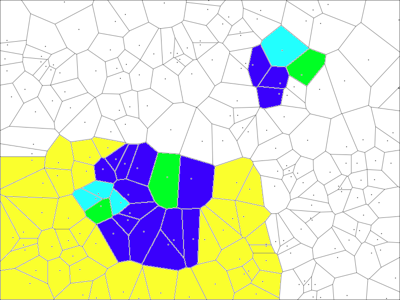 |
Realms
At the top of the hierarchy stands the realm. This is a generic term for empires, kingdoms and the like, but also for independent baronies, regions or even estates. The definition is simple: Anything that does not have anything else above it in the hierarchy is a realm.
Realms are marked in red to the right. To make the example clearer, the two realms in our example do not touch, though in the real game they usually would.
Realms also have names. Like regions, these are arbitrary, provided the realm consists of at least two regions. Single-region (or even single-estate) realms can not choose their name freely, but are always given the name of their capital settlement. Realm names consist of a short and a long form, with the long form containing ornamental titles. So the short form of a realm name could be "Keplerstan", while the formal/long name could be "Holy Empire of Keplerstan".
| 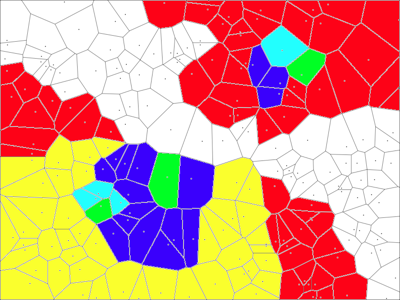 |
Example
This is a very, very rough example to illustrate the relation between the old and the new world.
In this overlay of the East Island, the voronoi cells are randomly generated, so they do not fit the existing landscape well.
Ocean tiles are marked in blue, the river is marked in light blue, region borders are painted over in red. Not all tiles or borders are marked, this is just an example, ok?
Nevertheless, you can see how each region would break down into several places, for example Tokat would consist of 6 individual places and could have somewhere between 2 and 6 estates (a single estate is not possible, since not all places border each other).
Note, however, that "Tokat" stops being a fixed entity. It could conquer, trade or otherwise get control of any place that borders it, e.g. the settlement to the north-west that makes up the "leg" of Sordidus, and thus grow larger. Or smaller. Or it could change shape.
You can see how a large city like Oligarch could be made up of several districts, or a small city like Fontan or Karbala is made up of one place. I have not yet decided if cities should always be one place exactly, both possibilities exist.






